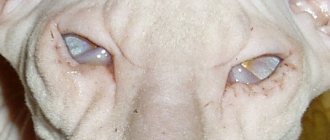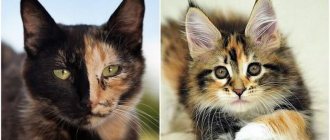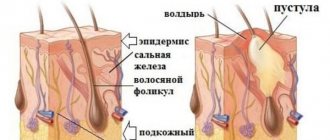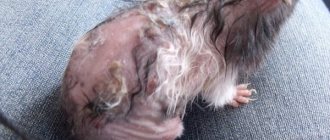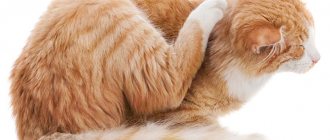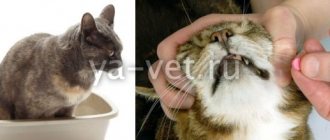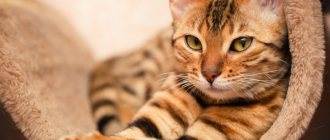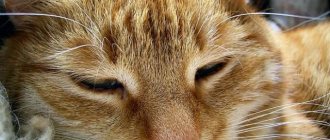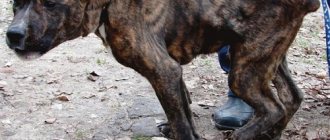Conjunctivitis
Sphynx kittens' eyes open much earlier than those of any other breed, so they are more susceptible to conjunctivitis (inflammation of the mucous membrane of the eyes).
The symptoms of this unpleasant disease are discharge from the eyes. In Canadian Sphynxes they can be in the form of transparent mucus or pus. With conjunctivitis, purulent crusts form around the eyes, causing the pet to begin rubbing its eyes with its paws. In rare cases, photophobia may occur during this illness.
To prevent this disease, the animal needs to wipe its eyes daily with a cotton swab dipped in boiled water at room temperature. It is recommended that kittens have their claws trimmed as often as possible.
Before starting treatment for conjunctivitis, you must thoroughly rinse your eyes and only then apply special drops.
It is recommended to wash the eyes of sphinxes with a weak solution of potassium permanganate.
For purulent inflammation of the eyes, instead of eye drops, it is better to use tetracycline ointment, which is placed behind the lower eyelid. If long-term treatment of sphinx eyes does not produce positive results, then veterinarians advise using hydrocortisone ointment.
Genetic problems
The genetic diseases of sphinxes are quite diverse. This is nipple hyperplasia, the provoking factor for the development of which is considered to be the abuse of hormonal drugs. If breeding is not planned, it is better to sterilize the animal rather than give drops during estrus that suppress sexual desire. They are, of course, effective, but in the end they can provoke this dangerous disease. The nipples become dense and change color to deep red. If left untreated, hyperplasia will cause cyst formation on the breast. Hairless cats from one year of age are at risk.
Microphthalmos is the cause of decreased visual acuity. Represents a reduction in the eyeball. The only possible treatment option is surgery.
Curvature of the spine in the caudal region is accompanied by a bend in the tip of the tail. Such pets are discarded: they are not allowed to breed and take part in exhibition events. Often such curvature is accompanied by other hereditary abnormalities.
Congenital entropion of the eyelids occurs due to the fact that the eyelids of representatives of the breed are very dense. Because of this, the eyelid bends inward, often the pathology is accompanied by conjunctivitis and purulent discharge.
Dangerous hereditary pathologies that can cause death include:
- Myopathy. It first affects the neck muscles, then spreads throughout the body.
- Hypertrophic cardiomyopathy is a heart pathology. Can cause sudden cardiac arrest.
- Airway obstruction. Also a common hereditary fatal disease.
To reduce the risk of buying a sick kitten, it is important to familiarize yourself with detailed information about the health status of the parents. In official nurseries, this information is publicly available and is provided upon the first request of a potential buyer.
Mastopathy
Mastopathy is inflammation or enlargement of the mammary glands and the formation of small nodules on them.
Mastopathy in Canadian Sphynxes occurs for a number of reasons: the animal’s skin has a special structure - it is folded, thickened and has many sebaceous glands. In addition to females, neutered cats are susceptible to the disease.
In rare cases, mastopathy in the Sphynx can turn into mastitis. Mastopathy is often associated with hormonal imbalance in the animal’s body, which is why it is better to immediately contact a veterinarian.
The symptoms of mastopathy and mastitis in the Sphynx are similar. With mastopathy, the mammary glands swell and harden, redness appears, and pain occurs on palpation. With mastitis, sphinxes have all of the above symptoms, but they are much more pronounced. With mastitis, the temperature almost always rises, and copious purulent discharge appears from the mammary glands.
As a therapeutic measure, the mammary glands of the Canadian Sphynx are rubbed with camphor oil daily.
To prevent mastopathy, veterinarians advise owners to feed their pet properly and never overfeed. It is recommended to provide the animal with proper care.
The key to the health of the Canadian Sphynx lies in a simple rule: the pet must lead an active lifestyle.
Treatment of blackheads
Treatment of lichen in a sphinx should be carried out under the supervision of a specialist, because incorrect actions by the owner can aggravate the situation. In addition, it is difficult to correctly diagnose yourself and it is not always possible to determine the disease from a “photograph”. Lichen therapy is carried out in 3 areas:
- Antifungal systemic therapy. Drugs in this group are Ketoconazole, Intraconazole, Terbinafine, Fluconazole, Gresiofulvin. Each is used strictly according to the regimen prescribed by the doctor. Changing the dosage and time of taking medications can negatively affect the health of the animal: an overdose has a bad effect on the liver, and a lack of a substance contributes to the disease becoming chronic.
- Local therapy. Works less efficiently than in humans. This treatment method is used as an additional method to avoid damage and contamination of the environment with spores. Treating the affected areas and washing the animal with the following medications helps:
- lime sulfur solution;
- miconazole solutions and shampoos;
- terbinafine solutions;
- clotrimazole sprays and creams;
- chlorhexidine solution.
Rabies
Rabies is an acute viral disease that is transmitted through saliva during the bite of a sick animal. The incubation period during an animal's illness can last from 30 to 50 days, in rare cases from 10 to 90 - it all depends on the location of the bite and the amount of saliva that gets into the wound. The closer to the nerve endings the bite falls, the shorter the incubation period. The most dangerous wounds for sphinxes are those that are in close proximity to the animal’s head.
During rabies, a Sphynx exhibits the following symptoms:
- loss of appetite,
- profuse drooling,
- vomit,
- diarrhea,
- in rare cases, constipation.
Throughout the entire period of illness, the pet becomes very aggressive. The Sphinx can attack not only animals, but also people and even its owner. It is very important to avoid cat bites as the disease is very dangerous for humans. During this period, coordination of movements is completely disrupted, they begin to hide in dark shelters so that no one will disturb them. The animal falls into a comatose state and then dies.
Unfortunately, today rabies in animals, like in humans, cannot be treated. For preventive purposes, veterinarians advise regular vaccinations from the age of three months. Rabies vaccinations are given only once a year.
Feeding adult cats and kittens
Kittens' bodies grow until they are 10 months old, so they need nutritious food. Already from the first months of life, sphinxes are accustomed to solid food and given boiled veal. Pork is prohibited (by the way, as is lop ears), as it is fatty and can cause digestive problems.
At 4 months, small quantities of sea fish with the bones removed will be useful. From 6 weeks it is allowed to give yolk and cottage cheese. The owner himself chooses the number of feedings, but it is recommended to accustom the animal to a specific regimen.
The animal should have free access to food, they are not prone to overeating, but food helps them stay warm when freezing.
The basic rules for feeding Sphynx kittens, which they get used to and then eat like this for the rest of their lives, are:
- The menu must include meat. The daily norm is 30% of the body weight of a kitten or adult cat. Healthy protein is also present in fish and cottage cheese. You need 200 g per day.
- One third of your diet should consist of carbohydrates. These are a variety of porridges - buckwheat, rice, oatmeal. The Sphynx also needs fresh vegetables with the addition of 5 - 10 g of unrefined sunflower oil.
- In winter, portions for your pet should be larger.
- Sphynx cats have an accelerated metabolism, which requires a large amount of energy from food.
- You can also feed your animal with ready-made food - but not below premium class. This food must be selected specifically for this breed.
The health of the growing body will depend on the correctness of the diet.
Food allergies
Sooner or later, the Canadian Sphynx may develop a food allergy, which is accompanied by severe itching. When an animal is allergic, itchy skin, pimples, and red spots appear on the face, paws and neck. All these signs indicate serious disorders.
Due to the lack of fur, Sphynx cats are most prone to exhibiting a wide variety of allergic reactions. This is due to the fact that Sphynx cats receive a huge amount of not only proteins, but also food colorings and fillers from their food. Excess proteins, when processed by the immune system, can be recognized as foreign substances that must be destroyed. As a result of this process, the animal has problems not only with inflammation of the digestive tract, but also other organs. However, only the skin suffers from immune system problems. As a result, the Sphynx develops pimples that cause severe itching.
It takes quite a long time for an animal to develop a food allergy. Many Sphynx cats can eat the same food, which only after a few years can cause a response in the body. Therefore, acne and itching in sphinxes may indicate a completely different disease, for example, sarcoptic mange or epizootology, for the treatment of which completely different drugs are intended. That is why it is better to immediately contact a veterinarian to determine the correct diagnosis and, therefore, treatment.
Feeding adult cats and kittens
Kittens' bodies grow until they are 10 months old, so they need nutritious food. Already from the first months of life, sphinxes are accustomed to solid food and given boiled veal. Pork is prohibited (by the way, as is lop ears), as it is fatty and can cause digestive problems.
At 4 months, small quantities of sea fish with the bones removed will be useful. From 6 weeks it is allowed to give yolk and cottage cheese. The owner himself chooses the number of feedings, but it is recommended to accustom the animal to a specific regimen.
The animal should have free access to food, they are not prone to overeating, but food helps them stay warm when freezing.
The basic rules for feeding Sphynx kittens, which they get used to and then eat like this for the rest of their lives, are:
- The menu must include meat. The daily norm is 30% of the body weight of a kitten or adult cat. Healthy protein is also present in fish and cottage cheese. You need 200 g per day.
- One third of your diet should consist of carbohydrates. These are a variety of porridges - buckwheat, rice, oatmeal. The Sphynx also needs fresh vegetables with the addition of 5 - 10 g of unrefined sunflower oil.
- In winter, portions for your pet should be larger.
- Sphynx cats have an accelerated metabolism, which requires a large amount of energy from food.
- You can also feed your animal with ready-made food - but not below premium class. This food must be selected specifically for this breed.
The health of the growing body will depend on the correctness of the diet.
Rhinotracheitis
Rhinotracheitis is an acute viral disease that affects the eyes and respiratory system of a pet. Absolutely all breeds of cats are susceptible to this disease, regardless of age. Having recovered from rhinotracheitis, the animal gains immunity.
The very first symptom of rhinotracheitis is sneezing. Throughout the entire period of the disease, the Sphinx does not lose its appetite.
The incubation period for rhinotracheitis in Sphynx cats lasts from 1 to 8 days. If an animal sneezes frequently, it must be isolated from other pets, since the virus is transmitted by airborne droplets. During illness, inflammation of the mucous membrane of the eyes begins to rapidly develop in animals, a severe runny nose appears and breathing becomes difficult. As this very unpleasant disease progresses, Sphynx cats' condition quickly deteriorates. The temperature rises and there is even severe inflammation of the trachea, bronchi and lungs. As soon as you notice the first similar symptoms in your pet, you should immediately seek help from a veterinarian who can correctly prescribe treatment for the animal.
Urolithiasis in sphinxes
Dangerous diseases of the Canadian Sphynx include urolithiasis (UCD). The reasons are the animal's physical inactivity, obesity, poor diet, and insufficient fluid intake. Often, KSD is provoked by an infection in the urethra.
Neutered Sphynx cats are at risk. It is important to give your pet a preventive medication approved by your veterinarian every year.
Hairless cats are original pets. However, they develop strong immunity only with age, and many dangerous diseases are hereditary. Only an attentive owner is able to notice the first signs of illness and take the pet to the clinic in time.
